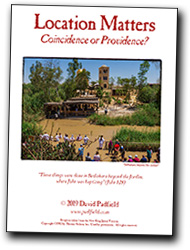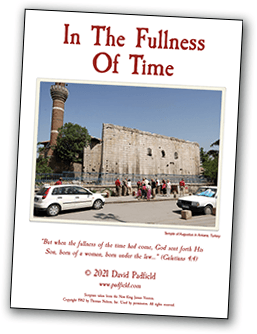Free Books On Bible History And Geography
Israel
Jewish Sects of the Second Temple Period contains a series of sermons on Jewish sects. Nearly every Bible student is familiar with at least two of the sects of the Jews that are mentioned in the New Testament, i.e., the Pharisees and the Sadducees. A careful reading of the Gospels reveals two other powerful parties—the Herodians and the Zealots. From ancient Jewish sources and secular history, we learn of two more sects—the Essenes and the Sicarii. In this study, we examine the six main Jewish sects of Second Temple Period (i.e., the period in ancient Israel between the construction of the Second Temple in Jerusalem in 516 B.C. and its destruction by the Romans in A.D. 70). These outlines include much more information than was presented in the lessons—this is for the benefit of students who are not afraid to delve into the weightier matters of Biblical studies. These outlines also include additional source material to which many Bible students do not have ready access (30 pages; PDF file size: 627k).
The Great Sanhedrin in Jerusalem was the highest religious, political, legal, legislative, and judicial body among the Jews during the Second Temple period. This body was composed of 71 members, presided over by the High Priest. The Sadducees, a sect mainly composed of priests, dominated the Sanhedrin, but the Pharisees were also represented. This book contains six sermon outlines dealing with the history, organization, and power of the Sanhedrin. It also covers the trials of Christ and His apostles (45 pages; PDF file size: 4.5MB).
Lucius Aelius Sejanus was executed for treason on October 18, AD 31, and just a year and a half later, on April 3, AD 33, our Lord stood before Pontius Pilate. Sejanus is not mentioned in any of the four gospels, but his shadow is seen in Pilate's judgment hall (12 pages; PDF file size: 811k).
 Location Matters is a new sermon book that examines several New Testament stories and shows how the location of the event has a great deal of bearing on our understanding of the story. These sermons discuss the "background story" at Bethabara beyond the Jordan, Capernaum, Nain, Caesarea Philippi, Antioch of Pisidia, and Athens (13 pages; PDF file size: 997k).
Location Matters is a new sermon book that examines several New Testament stories and shows how the location of the event has a great deal of bearing on our understanding of the story. These sermons discuss the "background story" at Bethabara beyond the Jordan, Capernaum, Nain, Caesarea Philippi, Antioch of Pisidia, and Athens (13 pages; PDF file size: 997k).
Jerusalem, The City Of Our God. This new booklet includes a discussion of the history of Jerusalem from the time of Abraham until the Moslem invasion of the Holy Land. There is also a section on sites to see in Jerusalem today. This free 35-page booklet also has a complete bibliography and twenty color photographs (PDF file; 3MB).
Days Of Vengeance. Jesus called the destruction of Jerusalem the "the days of vengeance" (Luke 21:22). The destruction of Jerusalem was an act of God's vengeance and judgment, not Rome's. The destruction of the holy city was not an accidental or arbitrary act, but the just recompense of reward for those who rejected God's Son. This book is a very detailed examination of the destruction of Jerusalem and a look at the events which followed (32 pages; color photographs; PDF file size: 767k).
Every Man Under His Fig Tree: Glimpses Of Life In Bible Times. This series of sermons draws valuable lessons for us from life in Bible times. The sermons include: 1) Every Man Under His Fig Tree, 2) The Potter And The Clay, 3) Women Grinding At The Mill, 4) On The Doorposts Of Your House, and 5) What The Centurion Saw (PDF file size: 572k).
The Abominations of the Canaanites. The book of Deuteronomy contains a remarkable passage that explains the origin of the prophetic institution in Israel. The passage also stands as a warning to the Israelites who were about to enter Canaan, for there is a long list of the abominations of the Canaanites described here as well. The destruction of the Canaanites was not an attack on an innocent people; instead, it was God's righteous judgment against abominable sin. This free booklet describes what the "abominations of the Canaanites" actually involved, and then it shows how Moses was different from all of the other Old Testament prophets of God. The final section shows how Jesus Christ was "the Prophet" that Moses said would come after him (PDF file size: 249k).
The Biblical City Of Caesarea Maritima (2nd edition, 2021). This twelve page booklet includes an outline on the history of Caesarea Maritima and the importance of this city in the New Testament. Also included are two maps and color photographs (PDF file size: 2.3MB).
The Biblical City Of Caesarea Philippi (2nd edition, 2015). It was in the region of Caesarea Philippi that Jesus asked His disciples, “Who do men say that I, the Son of Man, am?” and where Peter answered and said, “You are the Christ, the Son of the living God” (Matthew 16:13, 16). This new booklet describes the city of Caesarea Philippi, its significance in Biblical times and its archaeological ruins. Caesarea Philippi was an area scattered with the temples of ancient Syrian Baal worship and a cave near Caesarea Philippi is said to be the birthplace of the Greek god Pan, the god of nature, fields, forests, mountains, flocks and shepherds. The cave at Caesarea Philippi is the easternmost source of the Jordan River—this alone would make the area full of emotion for the Jews. In the New Testament age there was also a great temple of white marble built to the godhead of Caesar. This booklet includes color photographs of the area and a complete bibliography (PDF file size: 1.9MB).
The Biblical City Of Capernaum. A detailed outline describing the city of Capernaum, its significance in Biblical times and its archaeological ruins. Includes color photographs and a map (12 pages; PDF file size: 9.5MB).
Matthew 24 And The Destruction Of Jerusalem. This article shows how the events described in Matthew 24 were fulfilled in 70 A.D. when Titus, the Roman general, destroyed the city of Jerusalem. Six pages, with map of Jerusalem (PDF file size: 248k).
Egypt
Against All The Gods Of Egypt (2nd edition, 2015). A detailed study of the plagues Jehovah sent to punish the land of Egypt and her gods during the time of Moses. Special emphasis is given to showing how each plague was a direct insult to the gods in Egypt (56 pages with color photographs; PDF file size: 3.2MB).
Turkey
The Biblical City Of Antioch Of Pisidia. Around 50 A.D., the apostle Paul visited Antioch of Pisidia on his first evangelistic journey and his first recorded sermon was preached there. Antioch of Pisidia is located one-half of a mile north of the village of Yalvac in the Isparta province in southern Turkey. This book is a detailed outline describing the city of Pisidian Antioch, its significance in Biblical times and its archaeological ruins. Includes several color photographs (2nd edition; PDF file size: 2.1MB).
The Biblical Cities Of Laodicea, Colosse, And Hierapolis (2nd edition, 2015). In the New Testament, three churches in the Lycus River valley in Asia Minor sounded forth the word of God. Paul wrote an epistle to the church at Colosse and mentioned the brethren at Laodicea and Hierapolis. Laodicea was also one of the "seven churches of Asia" mentioned by John in the book of Revelation. Includes bibliography and over a dozen color photographs (PDF file size: 3.2MB).
The Biblical City Of Ephesus (2nd edition, 2013). A detailed outline describing the city of Ephesus in Turkey (Asia Minor), its significance in Biblical times and its archaeological ruins. Includes several color photographs (PDF file size: 3.1MB).
Greece
The Biblical City Of Philippi (2nd edition, 2015). A detailed outline describing the city of Philippi, the first place Paul preached on European soil. Includes several color photographs (PDF file size: 2.4MB).
The Biblical City Of Corinth. A detailed outline describing the city of Corinth, Greece and its significance in Biblical times and its archaeological ruins. Includes several color photographs (PDF file size: 700k).
Bible Land History and Geography

In The Fullness Of Time. Our Lord came into the world at the perfect moment in human history, or, as Paul would say, He came “in the fullness of time” (Gal 4:4). Bible students can see God’s providential hand moving behind the scenes of human history to direct world events to prepare for the coming of His Son. Throughout the centuries, God’s divine oversight of the world’s affairs had prepared men and nations for the Messiah and the proclamation of the gospel. This book contains nine very detailed sermon outlines that explain why the first century AD was the perfect time for Christ to come into the world (80 pages with 20 color photographs; PDF file size: 16 MB).
The Early Years Of Saul Of Tarsus. On the great day of Pentecost, Jews from throughout the Greco-Roman world traveled to Jerusalem to worship God. While Jews were found in every nation throughout the civilized world, anti-Semitism flourished. Among the nations of antiquity, no nation was ever hated as much as Israel. If Christianity were ever going conquer the world, then someone would have to bridge the gap between Jews and Gentiles. In the providence of God, Saul of Tarsus was selected. This new book on focuses on Saul's Jewish roots, his birth in Tarsus of Cilicia, and his education "at the feet of Gamaliel." This book contains numerous color photographs from Tarsus of Cilicia (modern day Turkey). (PDF file size: 1.3MB).
Location Matters. When studying the Bible, you should always keep the location of Bible events in mind. The Bible contains no filler material—every word in Scripture is there for a reason. As you study the gospels and find a city mentioned by name, you should always stop and ask yourself, "What happened here before?" For example, even the most casual of Bible students know that Jesus was born in Bethlehem of Judea. Bethlehem was the ancestral home of David, Israel's most beloved king. Thus, it is fitting that the one who would sit on "David's throne" would be tied to that great king by ancestry and a shared hometown. This booklet examines several New Testament stories and shows how the event's location dramatically affects our understanding of the story. (PDF file size: 975k).
The Praetorian Guard. The lesson outline discusses the importance of the Roman Praetorian Guard and how they had an impact on the life of Paul and the growth of the New Testament church. The Praetorian Guard’s primary role in the New Testament age was to protect the emperor and imperial family and to quash any potential rebellions, and they were the only military force allowed in the capital. Prisoners sent to Rome from the provinces in appeal cases, like the apostle Paul, were entrusted to the care of the prefect of the praetorian guard (8 pages; PDF file size: 2.3MB).
The Destruction Of Tyre (third edition, 2023). Tyre, the famous Phoenician seaport, was located 20 miles south of Sidon on the Mediterranean coast. The prophet Ezekiel foretold the destruction of Tyre centuries before Alexander the Great cast the ruins of the ancient city into the sea (PDF file size: 217k).
The British Museum And The Bible. A four page outline detailing some of the relics from various Bible lands to be found in the British Museum (PDF file size: 275k).
Timeline For The Book Of Genesis. A single page handout in 8.5 by 14 inch format. Gives an overview of the book of Genesis in chronological order (PDF file size: 96k).
